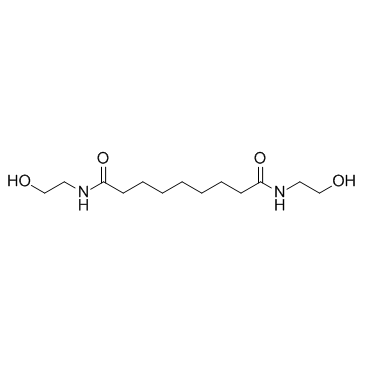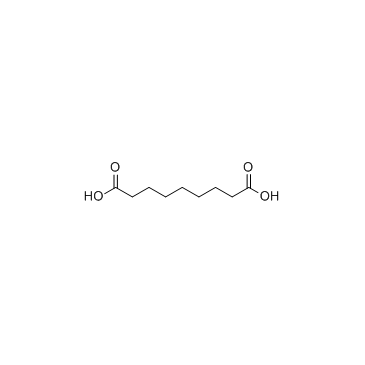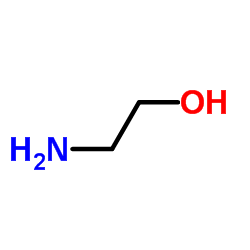1675-66-7
| Name | N,N'-bis(2-hydroxyethyl)nonanediamide |
|---|---|
| Synonyms |
Adelmidrol
UNII-1BUC3685QU |
| Description | Adelmidrol exerts important anti-inflammatory effects that are partly dependent on PPARγ. Adelmidrol reduces NF-κB translocation, and COX-2 expression. |
|---|---|
| Related Catalog | |
| Target |
NF-κB COX-2 PPARγ |
| In Vitro | Adelmidrol is a palmitoylethanolamide analogue. Adelmidrol reduces NF-κB translocation, COX-2, and p-ERK expression; proinflammatory cytokine release; and the incidence of nitrotyrosine and poly(ADP)ribose in the colon[1]. |
| In Vivo | Adelmidrol (10 mg/kg, o.s.) reduces significantly the degree and severity of the macroscopic and histologic signs of colon injury. Moreover, 4 days after colitis induced by dinitrobenzene sulfonic acid (DNBS) treatment, all mice have diarrhea and a reduction in body weight (compared with the sham groups). Adelmidrol (10 mg/kg, o.s.) treatment significantly reduces the loss of body weight. The inflammatory bowel disease (IBD) induced by DNBS intrarectally administered is also characterized by an augmentation in myeloperoxidase (MPO) activity, an indicator of neutrophil accumulating in the colon. This is consistent with light microscopic observations showing the colon of vehicle-treated DNBS mice to contain a large number of neutrophils. In contrast, Adelmidrol (10 mg/kg, o.s.) significantly reduces the degree of polymorphonuclear cell infiltration (determined as reduction in MPO activity) in inflamed colon[1]. |
| Animal Admin | Mice[1] Male adult CD1 mice (25-30 g) and male mice (20-27 g) are placed in a controlled environment and maintained on a 12-hour light/dark cycle with food and water available ad libitum. Mice are casually divided into the following groups (10 in each group) (1)Sham+vehicle group: Vehicle solution (saline) is given by oral administration for 4 days. (2) Sham+Adelmidrol (10 mg/kg): Administered o.s. for 4 days. (3) DNBS+vehicle: Mice are injected by DNBS as described, and vehicle (saline) is given o.s. each day for 4 days, starting 60 minutes after the injection of DNBS. (4) DNBS+Adelmidrol (10 mg/kg): Mice are injected by DNBS as described, and Adelmidrol (10 mg/kg) is given o.s. each day, starting 60 minutes after administration of DNBS[1]. |
| References |
| Density | 1.097g/cm3 |
|---|---|
| Boiling Point | 596.4ºC at 760mmHg |
| Melting Point | 132-134 ºC |
| Molecular Formula | C13H26N2O4 |
| Molecular Weight | 274.35700 |
| Flash Point | 314.5ºC |
| Exact Mass | 274.18900 |
| PSA | 98.66000 |
| LogP | 0.71590 |
| Vapour Pressure | 1.04E-16mmHg at 25°C |
| Index of Refraction | 1.492 |
| Storage condition | 2-8℃ |
| Water Solubility | Soluble (60 g/L) (25 ºC) |
|
~77% 
1675-66-7 |
| Literature: LIFEGROUP S.p.A. Patent: EP550008 A2, 1993 ; |
|
~80% 
1675-66-7 |
| Literature: Lifegroup S.P.A. Patent: US5925678 A1, 1999 ; |


